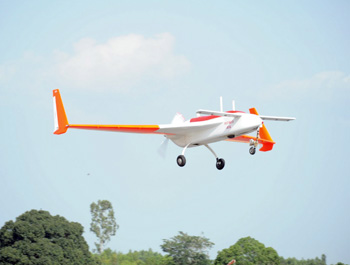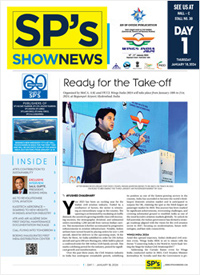- Prime Minister Narendra Modi inaugurates Aero India 2023 in Bengaluru; Releases Commemorative Stamp
- Defence Secretary meets delegations from Saudi Arabia, USA and Oman on the sidelines of Aero India 2023
- Foreign Ministers of 32 countries to attend Aero India 2023
- Embraer showcases the C-390 Millennium at Aero India 2023
UAVs big and small on show

Even with the robust indigenous unmanned aerial vehicle programme currently on, the market for unmanned aerial vehicles (UAVs) is huge in India. The three Indian armed forces and the paramilitary forces are all scouting for different classes of UAVs. While the Army, which is in the process of inducting the Indian Nishant RPV for surveillance operations, needs more drones to augments its fleet of IAI Searcher Mk.2s, the Navy needs specialty craft including ship-borne rotary-wing UAVs and long range armed medium altitude UAVs to expand its surveillance footprint along India's massive coastline and for deterrence. The Air Force, which is looking with increasing interest at unmanned combat aerial vehicles (UCAVs) has thrown its weight behind an Indian project, codenamed AURA, to build a stealthy flying wing UCAV that will be able to deploy smart munitions when ready. The only operational surveillance UAVs in Indian service right now are IAI Searcher Mk.2s, IAI Herons, Harop UCAVs and a small number of Indian-built Nishant surveillance drones.
The Indian Navy is actively scouting high performance UAVs. In 2010, it invited information to support a potential acquisition of an unspecified number of high-altitude long endurance (HALE) UAVs, specifying that it wants a platform with at least 25 hours mission endurance, an all up weight of no more than 15 tonnes, service ceiling of 40,000 feet and cruise speed of 100 knots. The Navy is also in the process of finalising its plans to acquire deck-based rotorcraft UAVs. The Navy decided to go in for an import option after the IAI-HAL NR-UAV remains in development trials and won't be ready for the next couple of years at least (Northrop has in fact told the Navy that the NR-UAV won't be a mature product, and therefore doesn't make sense). As it expands its footprint in the Indian Ocean region (IOR), the Navy requires a ship-based unmanned aerial capability for beyond the horizon surveillance, fleet intelligence gathering, targeting and reconnaissance.

India also has a huge requirement for micro air vehicles. Alongside a robust MAV programme within the country (the SLYBIRD MAV was unveiled for the first time at Aero India last year), the Indian Air Force in 2010 invited information from global vendors towards a potential purchase of (an unspecified number of) micro air vehicles (MAVs). According to the RFI, the MAV needs to weigh no more than 2 kgs with an endurance of anything over 30 minutes. The IAF has stipulated that the MAV needs to be a vertical takeoff and landing (VTOL) type, with payload requirements including day CCD camera and FLIR.
It may be noted that the Army is looking to induct the indigenous DRDO-ideaForge Netra MAV. Also, the Honeywell RQ-16 T-Hawk has been demonstrated to the Indian forces in the forests of Bastar, Central India, for potential use in anti-naxal operations. India's NAL is known to be developing a series of MAVS, but none are known to be VTOL platforms, opening up the market for these specialty systems. The Indian paramilitary forces, administered by the Ministry of Home Affairs, are also in the market for UAVs that will be committed towards internal security duties.
Interestingly, a tri-service requirement of high altitude long endurance (HALE) UAVs has been in the works since 2009 in India for an unspecified number of such systems for the Army, Navy and Air Force. The request for information (RFI) specifies that the companies interested in bidding for the contract should field UAVs with a minimum baseline capability configuration of 35,000 feet ceiling altitude, 24-hour endurance, 250-km direct line-of-sight data link, 350-km relay line-of-sight data link and with a satellite communication (SATCOM) capability. The RFI's system overview specifies that the package should contain day and night sensor payloads; ground/aerial data relay terminals, mobile receiving stations and intracommunication systems. The RFI specifies that the fielded UAVs must demonstrate profiles including (but not limited to) all-weather day/night reconnaissance of area, axis or point, transmission of radar/IR charge couple device imagery pictures of a benchmark (to be decided) resolution, real-time engagement of targets by directing artillery fire, and as a communication relay platform to facilitate multi-mode and multi-band communication over a wide area.





